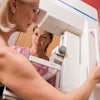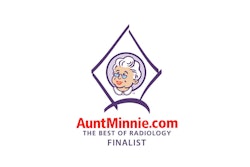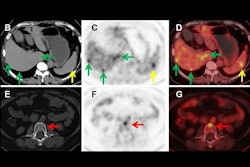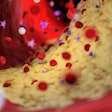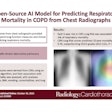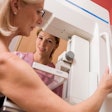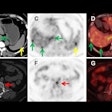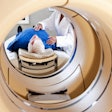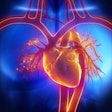Minnies finalists, page 2
Best Radiologist Training Program
Penguins versus Flyers, cheesesteaks versus Primanti Bros., Sheetz versus Wawa. Our expert panel will now be deciding the winner in yet another Keystone State Rivalry between Pittsburgh and Philadelphia, this time for Best Radiologist Training Program. One finalist is seeking its first Minnies award, while the other makes appearances seemingly every year in multiple Minnies categories.
Allegheny Health Network, Pittsburgh, PA
In contention for its first Minnies award since the competition’s inception, Allegheny Health Network (AHN) has a lot going for it in training the next generation of radiologists.

AHN’s diagnostic radiology residency is a four-year program that has students undergo hands-on training, a didactic curriculum, and multidisciplinary conferences. Students work with a wide range of imaging modalities, including CT, ultrasonography, MRI, PET, catheter angiography, and radioisotopic scanning. They also learn about plain-film radiography, fluoroscopy, and arthrography. Clinical rotations are organized by subspecialty and are assigned at four-week intervals.
Residents can also work in a night float system, and those in years one through three spend one month annually at UPMC Children’s Hospital.
Among other features, residents can gain radiologic pathology experience via a four-week course given by the American Institute for Radiologic Pathology. They also take part in multidisciplinary intradepartmental conferences and journal clubs.
Program staff say that AHN’s board-certified faculty, high retention, and diverse caseloads add to the network’s success.
“They love to teach the residents and in turn, the residents teach the students and observers they have,” said Residency Program Coordinator Lilly Perry. “That gets the word out, I think.”
Melissa Laity, senior residency program coordinator, said winning a Minnie award would be a great accomplishment for AHN’s radiology department.
“We’re really excited about this,” Laity said. “[It’s] the overall sense of pride in what we’re doing in educating radiologists.”
And for those interested in what the city of Pittsburgh has to offer, residents can enjoy concert venues, professional sports, world-class museums, parks, and riverside biking trails, among other amenities. And with AHN being the official medical provider for the Pittsburgh Pirates, residents rotating through the musculoskeletal radiology track are exposed to sports medicine studies and procedures at the professional sports level.
University of Pennsylvania, Philadelphia, PA
A regular contender every year in the Minnies and hanging its hat on being America’s first university, Penn continues to be a trailblazer in radiology, including for training radiologists. Penn's two-year run as Best Radiologist Training Program was broken in 2024, but it's now seeking to start a new winning streak.
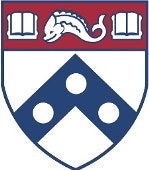
Penn Radiology provides educational opportunities for residents, fellows, and students and offers residencies in diagnostic and interventional radiology. It also offers education tracks such as a research track, a business and innovation track, a Tomorrow's Educators and Clinicians in Healthcare (TEACH) track, and a healthcare leadership in quality track. It also offers opportunities in informatics and global health. Additionally, Penn Radiology provides one or two-year fellowships in eight clinical subspecialties, as well as postdoctoral research fellowships in both basic and clinical disciplines.
And trainees interested in interventional radiology can work with a CT-fluoroscopy suite, two C-arm suites, two procedural CT scanners, a preprocedural suite, and a large postprocedure recovery suite. The Perelman Center also has two C-arm suites, a venous ablation suite, and a dedicated interventional radiology clinic with four clinic rooms and provider workroom areas.
Residents also work with a diverse case mix from multiple hospitals within and associated with Penn Medicine, including reading radiographs, working on independent call shifts, and working in a night float system.
Over 100 basic science and clinical faculty lead the charge for the multidisciplinary curriculum.
“The faculty really care and really enjoy education,” said Bill Stavropoulos, MD, executive vice chair of radiology. “The depth and the breadth of the clinical experience here is unmatched.”
“Having won this award in the past, I think through Dr. Scanlon’s leadership, there’s no complacency in terms of maintaining and continuing the excellence in not only training residents to be future radiologists but really training folks to be future leaders,” said Bill Kirschner, chief administrative officer for the department of radiology.
And being in the fifth-largest city in the U.S., trainees will have no shortage of activities, whether it be exploring historic sites, attending sporting events, or wandering through art galleries.
So, which side of Pennsylvania will claim Minnies fame this year? We'll find out soon.
Best Radiologic Sciences Program
Quinnipiac University, Hamden, CT
A powerhouse in medical imaging, Quinnipiac has high numbers to back up its claim for being an every-year Minnies contender.

This includes an average first-time certification pass rate of about 84% over the past five years, a 100% job placement rate, and a 94% program completion rate in 2024. But if you ask Kori Stewart, PhD, program director of radiologic sciences, the university’s success lies within the faculty.
“We are mentors who are deeply invested in student success,” said Stewart, an alumna of the university and the 2024 Minnie winner for Most Effective Radiologic Sciences Educator. “We emphasize critical thinking, ethical practice, compassionate care, and we are a multi-modality team.”
This is further exemplified by iQ, Quinnipiac’s holistic approach to career development and experiential learning. Within iQ is the Career and Experiential Learning Lab, a physical space where students and advisers can collaborate.
Students pursuing a Bachelor of Science degree in radiologic sciences are admitted to the three-year program. In the final year, students are eligible to sit for the American Registry of Radiologic Technologists (ARRT) certification exam. Quinnipiac also offers a Master of Health Science degree in advanced medical imaging and leadership. This means in four years, students can successfully earn both their bachelor's and master's degrees.
Students learn practical knowledge of radiology and radiation safety as well as physics, anatomy, and pathology through a combination of classroom, lab, and clinical experiences.
“From day one, they’re gaining that technical expertise and confidence in using these dynamic imaging systems,” Stewart said.
The university also holds affiliations with health networks in Connecticut and Massachusetts for trainees to gain further clinical experience. These include Hartford HealthCare, Yale New Haven Health, Massachusetts General Hospital, and Cape Cod Hospital.
All students participate in clinical rotations in both the second and third year of the program. And 57% of graduates from the 2024 radiologic sciences class reported enrolling in a graduate degree program at Quinnipiac.
Mayo Clinic College of Medicine and Science, Rochester, MN
Did you know the Mayo Clinic has its own college? Well, now you do, and the College of Medicine and Science wants you to.
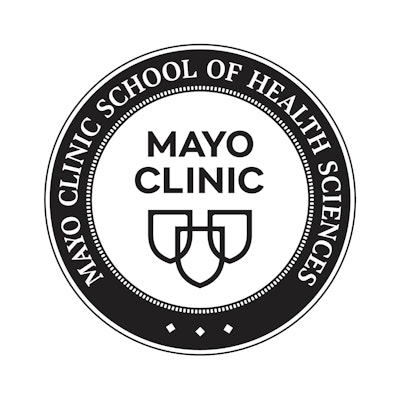
While the Mayo Clinic has won several Minnies awards in the history of the competition, its college is seeking its first award in this category. The College of Medicine and Science has an 18-month radiography program that boasts a nearly 97% licensure exam pass rate on the first attempt and a 100% job placement rate within 12 months after graduation.
The Mayo Clinic’s offerings include a hands-on curriculum that focuses on clinical training and lab work taught by experienced radiologic technologists. Experts come from a variety of areas within radiology, including breast imaging, CT, MRI, interventional radiology, and surgery. Trainees also work in various clinical settings and a level I trauma center to hone their skills with equipment and patients, including for nonroutine and emergency imaging.
The program’s goals include teaching trainees competency skills, critical thinking, and communication skills that will help them in their careers as technologists.
“I feel we are a premier program because of our partnership with Mayo Clinic,” said Program Director Jessica Lodermeier. “Students are completing their clinical rotations in a world-renowned institution. When they’re completing those rotations, they are working alongside and with current technologists in state-of-the-art facilities.”
Lodermeier said the college has embraced modern technologies while also keeping the tradition of face-to-face learning, which she added promotes collaboration and innovation.
“We not only teach the knowledge and skills of the profession, but we also focus on professionalism, patient-centeredness, altruism, and service excellence that distinguishes graduates of Mayo programs,” she said.
“I think it’s wonderful that the program is being acknowledged for what I believe we’ve provided for years,” Lodermeier added.
Most Significant News Event in Radiology
CT estimated to cause 5% of new cancer cases
In April, researchers led by Rebecca Smith-Bindman, MD, of the University of California, San Francisco (UCSF), published a study in JAMA Internal Medicine that suggested that cancers associated with radiation from CT scans could eventually account for 5% of all new cases annually.
The study results were based on a risk model developed using a multicenter sample of CT exams from UCSF's International CT Dose Registry that consisted of approximately 93 million scans performed on 62 million patients in 2023. The team also used market data from AuntMinnie's sister company IMV Medical Information Division in the analysis. It reported that roughly 103,000 radiation-induced cancers could result from the 93 million scans, with higher CT use accounting for most radiation-induced cancers.
The work prompted immediate pushback. The American Association of Physicists in Medicine (AAPM) argued that the benefits of CT exams outweigh the risk of radiation exposure, and the American College of Radiology (ACR) wrote that "the theoretical radiation risk proposed by Smith-Bindman, et al, is consistent with prior statistical modeling studies that are not based on actual patient outcomes … There are no published studies directly linking CT scans (even multiple CT scans) to cancer." The ACR also noted its longtime efforts to reduce inappropriate and unnecessary imaging and radiation exposure through the Image Gently and Image Wisely initiatives.
Will CT imaging truly boost cancer rates? More research will inevitably come, and AuntMinnie will track it closely.
Impact of NIH funding cuts on medical imaging research community
In March of this year, the U.S. National Institutes of Health (NIH) announced that grants and funding policies and processes were "evolving" as the NIH aligns with "new agency priorities," and it wrote that it was putting any posting of new funding opportunities and policy guidance on hold.
The news had an immediate effect on radiology, as researchers and policy experts sought to navigate the changed landscape. In fact, the NIH announcement came the same day as the annual Hill Day and #MedTech25 events were held in Washington, DC -- with participants advocating for medical imaging research and facilities and administration funding (F&A).
By May, academic radiology researchers continued to grapple with the "coming new normal" after the NIH's apparent $18 billion funding cut to health research spending. As of May 6, the Association of American Medical Colleges (AAMC) estimated NIH grant terminations would be $1.9 billion for all U.S. institutions combined, and just over $1 billion for medical schools and hospitals. At the end of that month, President Trump released a full federal fiscal year 2026 budget; in a June 4 statement, the American College of Radiology (ACR) warned that the proposed budget included a cut to the NIH of approximately $18 billion compared with 2025 levels, and it vowed to continue advocating for increased NIH and Advanced Research Projects Agency for Health (ARPA-H) funding.
But in September, appropriations bills were making the rounds in Congress, and a bill passed in the House provided $48 billion for the NIH, included funding for all 27 NIH institutes and centers, and did not implement President Trump’s budget request to cut NIH funding to $27.5 billion.
Unfortunately, the Senate appropriation bill remains in limbo, and the U.S. government has been in shutdown since October 1. AuntMinnie will monitor shutdown status and the bills that would dictate the NIH's funding.
Biggest Threat to Radiology
Radiology workforce shortages
For the past two years, workforce shortages in the field have been identified in the Minnies as the biggest threat to radiology. And it may be on its way to three in a row.
Two-thirds of academic and hospital radiology practices reported being understaffed in a survey led by the American College of Radiology (ACR) and the Radiology Business Management Association (RBMA). And nearly half of radiologists reported workforce shortages as their top concern in survey results published in January.
Medical societies continue to explore workforce trends and engage with policymakers and stakeholders to address these shortages. For example, imaging societies have created a joint workforce action plan that aims to raise awareness of multiple roles within radiology and radiation oncology. Societies involved in this plan include the American Society of Radiologic Technologists (ASRT), the ACR, the Society of Diagnostic Medical Sonography (SDMS), and the Society of Nuclear Medicine and Molecular Imaging (SNMMI), among others. And researchers continue to explore AI’s potential in aiding with this issue.
However, the data for now does not bode well for the workforce shortages to be alleviated anytime soon.
A study published in February by researchers from the Harvey L. Neiman Policy Institute (HPI) concluded that unless mitigating measures are taken, the current supply of radiologists in the U.S. and increased demand for imaging will likely lead to a continued workforce shortage.
Increased imaging volumes
The incessant growth in imaging volume has been of great concern to radiologists for many years, contributing directly to high levels of burnout and the ongoing radiology workforce shortages. And there's no sign of an improvement anytime soon.
Earlier this year, Neiman HPI researchers found that projected imaging utilization in 2055 is 16.9% to 26.9% higher than 2023 levels. This assumes that current per-person use will persist. And if recent trends persist through 2030, the projected imaging use in 2055 would range from 5.6% less to 45.2% more.
The same study also suggested that population growth would be a driving factor for these trends, accounting for 73% to 88% of imaging increases across modalities in 2055. And population aging would account for 12% to 27% of these increases.
Another study published this year found that between 2012 and 2023, radiology workload increased significantly, mainly due to increased CT and MRI use. And while CT and MRI exams per case-mix adjusted admission (CMAA) increased by about 19% and 21% respectively, professional relative value units (RVUs) increased by over 80% for CT and by about 91% for MRI.
So, what will be given the (dis)honor of “winning” a Minnies award in this category? Stay tuned and find out soon!
Hottest Clinical Procedure
Theranostics
Since its debut in the Hottest Clinical Procedure category last year, theranostics has continued to advance at a blistering pace.
The name theranostics is a portmanteau of "therapy" and “diagnostics" and refers to the dual approach of using the same molecular ligands to both image and treat cancer. It is a relatively simple concept that can be summed up with the expression, “See what you treat and treat what you see.”
So far, while just two drugs -- Pluvicto and Lutathera -- comprise the armamentarium of U.S.-approved therapeutics being used in the field, experts estimate that there are up to 300 in development worldwide for diseases ranging from prostate cancer to breast cancer. Coupled with an estimated 250 imaging agents in development, there’s no sign of a slowdown.
Moreover, spin-off concepts such as “neurotheranostics” and “theranostics informatics” took shape this year, while targeted alpha therapy is picking up steam.
Aside from wondering whether the practice will live up to its hype, there’s no doubt that theranostics will have a significant clinical impact and improve patient care, while taking precision medicine in cancer treatment to the next level.
Will this be the year for theranostics as the Hottest Clinical Procedure? Stay tuned to find out.
Remote MRI
While efforts to assess remote-controlled MRI -- whereby experienced technologists connect to MRI suites from distant locations to perform the scan -- began more than 20 years ago, the practice has spurred a flurry of activity recently.
In March, the American College of Radiology published a position statement on remote scanning and noted that it “supports the use of remote scanning as long as it is conducted in a manner that promotes patient safety, imaging quality, and personnel development.”
Remote scanning technology can enable experienced and specialized technologists to apply their expertise more broadly, improve productivity and patient access, and help optimize protocols, the ACR said.
Ultimately, remote scanning gained traction during the COVID-19 pandemic, yet now it appears here to stay. Moreover, some proponents suggest it can help mitigate the workforce shortage among technologists.
Meanwhile, companies from GE HealthCare to Siemens Healthineers to DeepHealth are continually improving the software platforms used to perform the procedures.
So, is it time for remote MRI to take its place on the podium with a win for Hottest Clinical Procedure? The Minnies expert panel will be taking a hard look.



